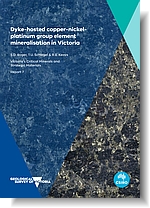VCMSM Report 7 - Dyke-hosted copper-nickel-platinum group element mineralisation in Victoria.
 |
| |||||||||||||||
Product description:Executive Summary:As part of the Developing Victoria’s Critical Minerals initiative new compositional and geochemical data were acquired to understand the presence and distribution of platinum group elements in mafic and ultramafic rocks of Victoria. This study investigated the largest occurrence currently known; the Thomson River copper-nickel-platinum group element deposit in east-central Victoria. The Thomson River deposit is hosted by cumulate amphibole and clinopyroxene-rich rock found within a 150 m long and up to 30 m wide, north-plunging, bulge within a late Devonian intrusion of the Woods Point Dyke Swarm. It is one of many similar dykes within this swarm, some of which also contain elevated copper, nickel and platinum group element values. All occurrences currently known have been identified by their presence at surface with little exploration for this type of mineralisation across the swarm. The most recent, albeit limited, exploration at the Thomson River deposit has identified mineralisation to a depth of at least 300 m below surface and a similar distance along strike to the north of historical workings. High-grade primary mineralisation occurs at the base of the dyke bulge with one diamond drill hole returning a 36 m intersection (303 – 339 m) comprising 1.75% Cu, 0.18% Ni, 1.1 ppm Pd, 0.8 ppm Pt, 8.6 ppm Ag and 0.3 ppm Au. Analyses of legacy samples from underground workings has yielded values up to 7.73% Cu, 0.13% Ni, 5.9 ppm Pd, 3.1 ppm Pt, 29.0 ppm Ag and 2.8 ppm Au. Low-grade mineralisation occurs elsewhere within the dyke. The Thomson River deposit includes elevated values of other critical minerals. In addition to platinum and palladium, selenium, tellurium and bismuth show positive correlations with copper. Cobalt shows a positive correlation with nickel. Mineralisation varies from disseminated to net textured, with the principal sulphide minerals comprised of chalcopyrite and pyrite, with pyrrhotite, pentlandite, siegenite and sugakiite also present. Palladium and platinum are present in merenskyite and sperrylite, respectively. Together with other mafic dykes and sills in the region, the rocks of the Woods Point Dyke Swarm represent the less voluminous component of a bimodal igneous suite dominated by shallow level granitoids and coeval dacitic and rhyolitic volcanic rocks. Collectively, these late Devonian (c. 385-360 Ma) igneous rocks occurred coincident with crustal extension and fluviatile sedimentation and are interpreted to reflect the thermal effects of asthenospheric upwelling and high-degree mantle partial melting; the latter requisite to yield the sulphide undersaturated mafic and ultramafic magmas capable of removing copper, nickel and the platinum group elements from the mantle. In contrast to other regions that host copper-nickel-platinum group element mineralisation, most of the mafic and ultramafic mantle magmas formed during this event in Victoria stalled enroute to the surface. The extensive magmatic underplating caused by the emplacement of these mafic magmas within the lithospheric mantle or lower crust, and the significant addition of advective heat this event caused, can be inferred from the volume of coeval silicic granitoids and volcanic rocks. The potential of Devonian dyke swarms to host copper-nickel-platinum group element mineralisation elsewhere in Victoria remains untested. Another potential mineral exploration target are the late Devonian to early Carboniferous mafic rocks intercalated with the Avon Supergroup. These rocks are coeval to slightly younger than the rocks of the Woods Point Dyke Swarm and, if these rocks are intrusive sills, their shallow-dipping geometry offers greater potential for accumulations of gravity settled copper-nickelplatinum group element mineralisation than the subvertical dykes and steeply plunging dyke bulges of the Woods Point Dyke Swarm. Regional sampling and geochemical analysis for copper and platinum group elements of the Devonian mafic and ultramafic rocks in Victoria will determine their sulphide saturation status and provide a first order constraint on their prospectivity. The origin and the geochemistry of the older Neoproterozoic to Cambrian and younger Palaeogene mafic and ultramafic rocks exposed in Victoria suggest that they are unlikely to host copper-nickel- platinum group element mineralisation. Bibliographic Reference: Boger, S.D., Schlegel, T.U. & Keays, R.R., 2025. Dyke-hosted copper-nickel-platinum group element mineralisation in Victoria. Victoria's Critical Minerals and Strategic Materials Report 7. Geological Survey of Victoria, Department of Energy, Environment and Climate Action, Melbourne, 75 pp. Download: The downloadable version of this report is supplied as (PDF 25 MB) & Attachments A1-A3 (ZIP 92KB). Related products:
| ||||||||||||||||


